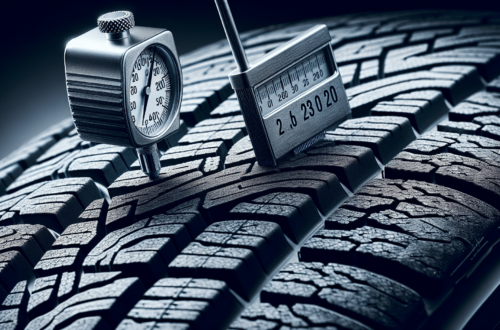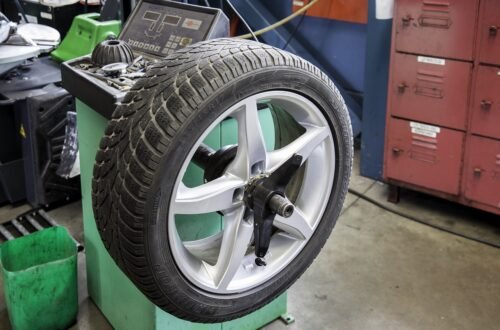Are you familiar with the dreadful experience of a tire blowout? The sudden burst, the jolt, and the panic that follows can be nerve-wracking. However, fear not! In this article, we will discuss practical ways that you can prevent tire blowouts and ensure a safe and smooth journey. By following some simple best practices, you can minimize the risk of this unfortunate situation and drive with confidence. So, let’s dive into these practical tips and keep those tires rolling!
Regular Tire Inspection
Regularly inspecting your tires is an essential part of maintaining optimal performance and safety on the road. By taking the time to check various aspects of your tires, you can identify potential issues early and take the necessary steps to address them. The following sections will guide you through the key points to focus on during your tire inspections.
Check Tire Pressure
Proper tire pressure is crucial for optimal performance and longevity of your tires. When your tires are underinflated or overinflated, it can affect your vehicle’s handling, fuel efficiency, and overall safety. To ensure the correct tire pressure, use a reliable tire pressure gauge and refer to your vehicle’s manual or the tire manufacturer’s guidelines. It is important to check tire pressure regularly, ideally at least once a month, and before any long trips.
Inspect Tire Tread Depth
The tread depth of your tires plays a vital role in providing sufficient traction on the road. As the tread wears down over time, the tire’s ability to grip the road surface diminishes, especially in wet or snowy conditions. To inspect your tire tread depth, you can use the “penny test.” Simply insert a penny into the tread grooves of your tires, with Lincoln’s head upside down. If you can see the top of Lincoln’s head, it’s time to replace your tires as the tread is too worn.
Look for Signs of Wear and Tear
Regularly examining your tires for signs of wear and tear can help you catch potential problems before they escalate. Keep an eye out for uneven wear patterns, bulges, cracks, or any other abnormalities on the tire sidewalls or tread surface. If you notice any of these signs, it may indicate an issue with the tire’s structural integrity. In such cases, it is best to consult a professional to determine whether the tire can be repaired or needs to be replaced.
Ensure Proper Tire Alignment
Proper tire alignment helps distribute the vehicle’s weight evenly across all four tires, ensuring even tire wear and better handling. Misaligned tires can lead to uneven wear and tear, causing premature tire failure and affecting your vehicle’s performance. If you notice your vehicle pulling to one side or experiencing steering wheel vibrations, it may indicate that your tires are misaligned. It is recommended to have your tire alignment checked by a professional regularly or if you suspect any alignment issues.
Proper Tire Maintenance
Regular maintenance is key to extending the lifespan and maximizing the performance of your tires. By following these essential tire maintenance practices, you can ensure your tires are always in top shape.
Rotate Tires Regularly
Rotating your tires involves moving them from one wheel position to another. This helps distribute the wear patterns evenly and ensures that all four tires wear at an equal rate. Most manufacturers recommend rotating your tires every 5,000 to 8,000 miles, or as advised in your vehicle’s manual. By following the recommended rotation pattern, you can enhance tire longevity and improve overall handling and performance.
Balance Tires
Balancing your tires involves adjusting the weights on the wheel to eliminate any imbalances. Imbalanced tires can cause uneven wear and tear, leading to a decrease in performance and a rough ride. Having your tires balanced regularly, especially after a tire rotation, ensures stability and even weight distribution, resulting in a smoother driving experience and extended tire life.
Replace Worn-Out Tires
Knowing when to replace your tires is crucial for maintaining safety on the road. As tires age, the rubber compound loses its elasticity, and the tread wears down, compromising traction and performance. It is essential to monitor the tread depth regularly and replace your tires when they reach the recommended minimum tread depth. Additionally, if you notice excessive wear, cracks, or bulges on your tires, it’s a clear sign that they need immediate replacement.
Use the Correct Tire Type for Your Vehicle
Using the correct tire type for your vehicle is essential to ensure optimal performance and safety. Tires are specially designed to meet the specific requirements of different vehicles, weather conditions, and driving styles. It is crucial to consult your vehicle’s manual or seek professional advice to determine the appropriate tire type and size for your specific needs. Using the wrong tires can result in poor handling, reduced fuel efficiency, and increased risk of accidents.

This image is property of images.pexels.com.
Maintaining Optimal Driving Habits
Your driving habits have a significant impact on the performance, longevity, and safety of your tires. By adopting these optimal driving habits, you can enhance your tire’s lifespan and minimize the risk of tire-related issues.
Avoid Overloading Your Vehicle
Overloading your vehicle can put excessive strain on your tires, leading to increased wear and tear and decreased performance. Refer to your vehicle’s manual to determine the maximum load capacity and ensure that you do not exceed it. Overloading can cause tires to overheat and increase the risk of tire blowouts, especially in hot weather or on long drives.
Moderate Your Speed
Maintaining a moderate and consistent speed not only improves fuel efficiency but also reduces the strain on your tires. High speeds generate more heat, increasing the risk of tire failure. It is important to adhere to speed limits and drive at a safe and reasonable speed that allows your tires to maintain their grip on the road. Additionally, avoiding sudden acceleration or braking can prevent unnecessary stress on your tires.
Avoid Sudden Braking or Acceleration
Sudden and aggressive braking or acceleration can cause excessive stress on your tires, leading to uneven wear and tear. Gradually decelerating and accelerating can help reduce the strain on your tires and improve their overall lifespan. Anticipate traffic conditions and signals in advance to avoid sudden maneuvers, allowing your tires to maintain traction and perform optimally.
Take Caution While Driving Over Potholes or Rough Roads
Potholes and rough roads pose a significant threat to your tires’ integrity. When driving over these obstacles, it’s important to proceed with caution to minimize the risk of damage. Slow down when approaching potholes and maintain a safe distance from the vehicle in front of you, as they may encounter the same hazards. Ensuring proper tire pressure and having sufficient tread depth can also help absorb the impact of potholes and reduce the likelihood of tire damage.
Avoiding Road Hazards
Being aware of potential road hazards and taking appropriate measures to avoid them can greatly reduce the risk of tire damage and other accidents. Follow these guidelines to navigate the road safely and protect your tires.
Scan the Road Ahead for Debris or Obstacles
Maintain a vigilant eye on the road ahead to spot potential hazards such as debris, rocks, or other objects that could puncture or damage your tires. Being proactive and avoiding these obstacles can prevent tire punctures or even blowouts. Adjust your route or change lanes if necessary to steer clear of any hazardous items on the road.
Steer Clear of Hazards Such as Broken Glass or Nails
Common road hazards like broken glass, nails, or sharp objects can easily puncture your tires and cause significant damage. When you encounter such hazards, carefully maneuver around them to minimize the risk of tire punctures. If avoiding the hazard is not possible, take extra caution and reduce your speed to minimize the impact on your tires.
Drive Around Potholes if Possible
Potholes can wreak havoc on your tires and suspension system. Whenever possible, try to steer clear of potholes by choosing an alternative path or changing lanes. If you cannot avoid a pothole, slow down and proceed carefully to mitigate the impact on your tires and reduce the risk of damage.
Be Cautious When Driving in Extreme Weather Conditions
Extreme weather conditions, such as heavy rain, snow, or ice, can amplify the risks on the road. These conditions reduce traction, making it harder to control your vehicle, especially if your tires are not in optimal condition. It is crucial to adjust your driving habits, drive at a safe speed, and leave ample distance between vehicles. Adhering to these precautions can help prevent accidents and minimize tire damage.

This image is property of images.pexels.com.
Proper Tire Repair
In the event of a tire puncture or damage, it is important to address the issue promptly to prevent further damage or potential accidents. Follow these guidelines for proper tire repair.
Inspect and Repair Tire Punctures Promptly
If you notice a nail, screw, or any other object embedded in your tire, it is crucial to inspect and repair the puncture promptly. Driving with a punctured tire can cause the object to shift or enlarge the hole, leading to a potential blowout. Consult a tire professional who can assess the damage and determine whether the tire can be repaired or needs to be replaced.
Avoid Using Temporary Tire Repair Sealants
While temporary tire repair sealants may seem like a quick fix, they are not a permanent solution. These sealants can cause imbalances within the tire, affect the tire’s structural integrity, and make it difficult to perform a proper repair. It is best to consult a professional and opt for a permanent repair that addresses the puncture effectively.
Consult a Professional for Tire Repairs
When facing tire repair issues, it is advisable to seek the assistance of a professional tire technician. They have the expertise and tools necessary to assess the extent of the damage and perform appropriate repairs. Proper repairs ensure that your tire maintains its integrity, minimizing the risk of future problems or failures.
Avoiding Underinflation
Underinflated tires can significantly impact your vehicle’s handling, fuel efficiency, and tire lifespan. Follow these guidelines to prevent underinflation and ensure optimal tire performance.
Regularly Check Tire Pressure
To prevent underinflation, it is essential to check your tire pressure regularly. Use a reliable tire pressure gauge to measure the air pressure in each tire and ensure that it matches the recommended levels provided by the tire manufacturer or your vehicle’s manual.
Follow the Recommended Pressure Levels
Each vehicle and tire has specific recommended air pressure levels. It is crucial to follow these recommendations to maintain optimal performance and safety. Underinflated tires can generate excessive heat, cause uneven wear, and increase the risk of blowouts. Overinflated tires, on the other hand, can result in a harsh ride, reduced traction, and potential damage to the tire.
Check Tire Pressure Before Long Trips
Before embarking on a long trip, it is essential to check your tire pressure, as extended driving can cause fluctuations in tire pressure. Ensure that all tires are properly inflated to the recommended levels to prevent underinflation during the journey. Remember to check the spare tire as well, as it may also require inflation.
Consider Using a High-Quality Air Pressure Gauge
Investing in a high-quality air pressure gauge can help ensure accurate readings and reliable tire inflation. Portable digital or analog gauges are available that allow you to quickly and easily check your tire pressure. These gauges typically provide more precise measurements compared to standard dial-type gauges, enabling you to maintain optimal tire inflation.

This image is property of images.pexels.com.
Preventing Overinflation
Overinflated tires can also lead to various issues, including reduced traction, harsh ride quality, and premature tire wear. Follow these guidelines to prevent overinflation and maintain ideal tire performance.
Maintain Recommended Tire Pressure
Following the recommended tire pressure levels, as provided by the manufacturer or your vehicle’s manual, is crucial to prevent overinflation. It is important to avoid inflating your tires beyond the specified levels, as this can negatively affect your vehicle’s handling and tire performance.
Avoid Overinflating Tires
Overinflating tires can result in reduced contact with the road surface, leading to compromised traction and an increased risk of hydroplaning, especially in wet conditions. Additionally, overinflated tires may be more prone to damage from road hazards and may wear out faster in the center of the tread. It is best to adhere to the recommended tire pressure levels and avoid exceeding them.
Do Not Solely Rely on the Tire Pressure Monitoring System
Many modern vehicles are equipped with a tire pressure monitoring system (TPMS) that alerts you when the tire pressure is low or high. However, it is important not to solely rely on this system. TPMS sensors may not always provide accurate readings, and it is still necessary to manually check the tire pressure regularly using a reliable gauge.
Proactive Replacement of Old Tires
Knowing when to replace your tires is essential for maintaining optimum safety and performance on the road. Paying attention to the signs of aging and deterioration can help you identify when it’s time for new tires.
Know When to Replace Your Tires
It is crucial to be aware of the signs that indicate it’s time to replace your tires. As a general rule, tires should be replaced every six years, regardless of tread wear. However, certain factors such as driving conditions, mileage, and tire type can influence this timeframe. Monitoring your tires and assessing their condition regularly will help you determine when replacement is necessary.
Follow the Manufacturer’s Recommended Lifespan
Tire manufacturers often provide an estimated lifespan for their products. Following these recommendations can guide you in determining when your tires should be replaced. While the estimated lifespan is a good guideline, it is important to consider other factors such as driving conditions and tire usage to make an informed decision.
Inspect Tires for Signs of Aging and Deterioration
Regularly inspecting your tires for signs of aging and deterioration is crucial for ensuring your safety on the road. Check for visible cracks, bulges, or sidewall damage, as these are clear indications that your tires are compromised and need to be replaced. If you notice any abnormalities or uneven wear, it is recommended to consult a tire professional for a more thorough evaluation.
Replace Tires with Excessive Cracking or Bulging
Excessive cracking or bulging on the tire sidewall or tread surface is a sign of serious tire damage. These issues can compromise the tire’s structural integrity and increase the risk of a blowout or sudden tire failure. If you encounter such damage during your inspection, it is imperative to replace the affected tires promptly to prevent hazardous situations on the road.
Proper Storage of Spare Tires
Spare tires are essential backup provisions, so it is crucial to store them appropriately to ensure they are ready for use when needed. Follow these guidelines for storing spare tires.
Store Spare Tires Away From Direct Sunlight
Direct sunlight can accelerate the aging process of tires, causing the rubber to deteriorate more quickly. It is important to store spare tires in a location away from direct sunlight, such as a garage, shed, or covered area. Protecting them from prolonged exposure to ultraviolet (UV) rays will help maintain their integrity and prolong their lifespan.
Keep Spare Tires in a Cool and Dry Location
Heat and moisture can also negatively impact the condition of spare tires. Storing them in a cool and dry location will help prevent the rubber from drying out or developing cracks. Avoid storing tires near sources of heat, such as furnaces or hot water tanks, as well as areas prone to moisture, like basements or damp environments.
Regularly Check the Spare Tire’s Condition
While spare tires may not be in regular use, they should not be forgotten. It is important to inspect the spare tire periodically to ensure it remains inflated, has sufficient tread depth, and is in overall good condition. Check for signs of aging, such as cracks or bulges, and address any issues promptly to maintain the reliability of your spare tire.
Regular Tire Rotation
Regularly rotating your tires is a vital maintenance practice that promotes even wear and extends their lifespan. Follow these guidelines for proper tire rotation.
Follow the Recommended Tire Rotation Pattern
Tire rotation patterns vary depending on factors such as tire type, vehicle design, and driving conditions. It is important to refer to your vehicle’s manual or consult a tire professional for the recommended rotation pattern. Following the correct rotation pattern ensures that each tire experiences different positions on your vehicle, leading to even wear and improved performance.
Rotate Tires Every 5,000 to 8,000 Miles
As a general guideline, it is recommended to rotate your tires every 5,000 to 8,000 miles, or as advised in your vehicle’s manual. Regular rotations prevent excessive tread wear on specific tires and lengthen the overall lifespan of your set. If you’re unsure about the timing or frequency of tire rotations, a tire professional can provide guidance specific to your vehicle and tire type.
Consult Your Vehicle’s Manual for Specifics
Each vehicle may have specific recommendations or considerations when it comes to tire rotations. It is imperative to consult your vehicle’s manual for any instructions or guidelines related to tire rotation. By following the manufacturer’s recommendations, you can ensure that your tire rotations align with the requirements of your vehicle, optimizing tire performance and safety.
By following these comprehensive tire care practices, you can maintain the longevity, performance, and safety of your tires. Regular inspections, proper maintenance, and proactive measures are all key factors in ensuring that your tires are always in optimal condition. Remember to consult your vehicle’s manual and seek professional advice when needed to address any specific tire care concerns. By investing time and effort into tire maintenance, you can enjoy a smooth and safe driving experience for miles to come.





